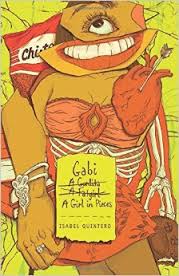There has been quite a few interesting match-ups over the course of this tournament, but I think this one might be one of the most diverse. Here I am…trying to choose between The Winner’s Curse by Marie Rutkoski and Gabi, A Girl in Pieces by Isobel Quintero. I thought for quite some time about some kind of link between both of these stories and while one is a realistic fiction book written in journal form and the other is a fantasy thriller. I finally found a common ground. If there’s one thing that a majority of teens can always commiserate about, it’s parents. Gabi and Kestrel could sit down and grab some coffee and talk for hours about how Gabi’s mom is constantly telling her she’s too American and will never get a man while Kestrel could unload the whole situation involving her father’s dream that she follow in his footsteps and choose a life in the military. It was this realization that helped me organize my thoughts a bit.
I’m not going to take the time to fully summarize the plot of either of these books. If you have been following the tournament, I’m sure you have an idea what the stories are about. In short, Gabi, A Girl in Pieces is the journal of a Mexican-American high school senior who is dealing with a plethora of monumental issues in the lives of her loved ones including teen pregnancy, coming out to your family, and meth addiction. Gabi uses her journal to organize her thoughts and emotions while uncovering her own identity through poetry. The Winner’s Curse is a thriller set in a world where the Valorians have successfully the Herrani people who are now employed as slaves. Kestrel, daughter of a high-ranking Valorian general, makes a spontaneous purchase at a slave auction which furthers her empathy for the Herrani people. With an uprising looming, Kestrel’s new relationship with Arin may sway on which side she plants her loyalty.
This is not an easy decision for me as I did not truly love either of these books. I enjoyed them both and will definitely recommend them to others, but neither left me wishing the book just a bit longer. I feel most people have already decided that Gabi, A Girl is Pieces will move on to the next round, but I’m not quite ready to set The Winner’s Curse on the back burner. Gabi started out slow for me. At first I thought it was an average book about a teen girl dealing with the same problems in every book. While that’s true, Quintero managed to grab me when I least expected it. Soon I could not stop reading the book. I read close to 3/4 of the book in one sitting. The connection was there and tears were flowing. The Winner’s Curse is a much different book. Gabi depends on its readers making the emotional connection and falling into Gabi’s life story. The Winner’s Curse depends on the drama of the story to catch the reader. While Gabi took a while for me to latch to her story, Kestrel grabbed me immediately. Her character was more likeable from the get go. Unfortunately I found some problems in The Winner’s Curse as well. The whole story depends on Kestrel purchasing Arin. Even after finishing the book, I still don’t know why Kestrel would get sucked into the auction and bid on Arin. It’s so out of her character. While I enjoyed the story, I kept going back to that fact the entire time.
I waited until the last minute to decide on a winner for this battle. I thought that maybe the answer would just appear to me in a dream sequence. Unfortunately I was not that lucky. I finally landed on a deciding factor. Gabi and Kestrel both have interesting stories. Out of the two, whose life would I want to continue experiencing? This may make me a bit unpopular, but I think that I have to choose The Winner’s Curse.
Winner: The Winner’s Curse



